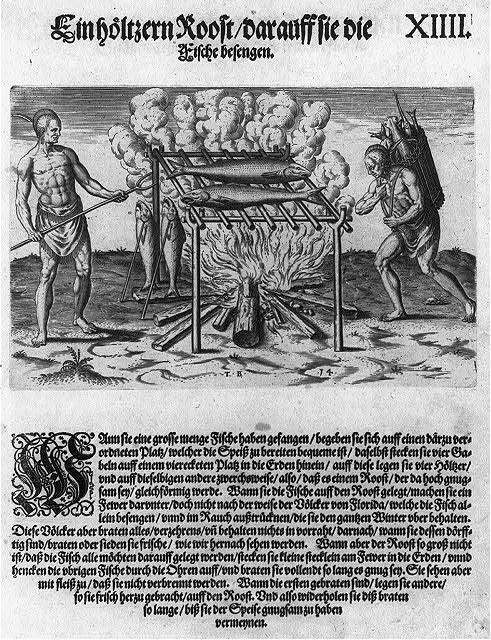Ingresa o regístrate acá para seguir este blog.
Hace un tiempo fui colaboradora en un proyecto financiado por la empresa GOYA FOODS (http://www.goya.com/espanol/about.html) para la realización de una bibliografía gastronómica comentada utilizando las colecciones de la Library of Congress de Washington. El pasado octubre fui entrevistada acerca de mi experiencia en este proyecto, a propósito del mes de la herencia hispánica en Estados Unidos. La base de datos tenía como tema central la alimentación en el mundo hispánico, es decir, América Latina, España y Portugal.
Aprovecho el espacio que me brinda este blog -originado en la experiencia que acabo de describir- para reproducir la entrevista que hoy se encuentra alojada en el blog de la Biblioteca del Congreso:
Inquiring Minds: Sabor! Latin American and Hispanic Cookbooks in the Library of Congress Collections
October 22, 2013 by Erin Allen
(The following is a guest post by Kaydee McCann, humanities editor for the “Handbook of Latin American Studies” and reference librarian in the Hispanic Division.)
Historian Natalia Silva Prada is a visiting researcher in the Hispanic Division of the Library of Congress. Supported by a fellowship from Goya Foods, she spent two months preparing an annotated bibliography of Latin American and Hispanic cookbooks from the Library’s collections. The bibliography will be made available in the coming months on the Hispanic Division website. She is continuing research in the Hispanic Division, writing a book on the role of political lampoons and political prophecies in 16th- to 18th-century Latin America.
Q: Why do you think there’s been a recent surge of scholarly interest in food history?
The growing interest in the history of gastronomy is really tied to two related subdisciplines – social history and cultural history. Social history took hold in the first half of the 20th century and cultural history reached a peak in the 1990s. The academic interest in the daily lives and experiences of ordinary people and in popular culture has recently been matched by a popular interest in food, cooking, restaurants and so forth. And you can see this interest reflected in the many television shows about cooking competitions and chefs, for example. So there’s been a sort of meeting of scholarly and popular interest.
Q: How many individual cookbook titles did you find during your research? And how many titles did you include in your bibliography?
There were many more titles in the Library on the food and cooking of Latin America and United States Hispanics than I expected to find. I located 1,300 titles and included 200 in the final bibliography. (I had two months to work on the bibliography, which placed some limits on the numbers of books that I had time to review and include).
Q: How did you decide which ones to include?
It seemed to me that it would be really interesting for people to know about the historical works from each country, so I included some of the oldest books. At the same time, I thought it would be really useful to highlight some of the most recent gastronomic works, so I looked for titles published between 1990-2012. I didn’t completely exclude works from other periods. For example, about two-thirds of the titles I included on Surinamese cooking were published in the 1970s.
Q: The Library has an incredible wealth of resources. How did you begin your research?
Before beginning a new project, a researcher has to do some investigation into previous bibliographic studies to understand which works are the best and what remains to be done. Earlier works help you understand what and how to search: specific terms and subject headings, specific concepts, specific authors. Bibliographic reviews are another essential tool for preselecting materials, for example the books that are indexed in the databases available at the Library of Congress and the abstracts in the “Handbook of Latin American Studies.”
Q: Food can be a way to maintain and preserve culture, and it can also be an indication of the influences that different cultures have on one another. Was there an identifiable moment when Latin American cooking emerged, as something new and separate from Spanish and Portuguese cooking?
And similarly, was there a moment when Hispanic/Latin American food-related influences began to find their way into mainstream U.S. tastes?
From the very first moment, when European and African populations made contact with the American continent, the foundations were established for new types of foods, new choices of food, new patterns of consumption and cooking. New tastes evolved and food taboos were broken as they tried new foods. European, indigenous, and African traditions all made a mark on New World cooking and eating.
As for the United States and Mexico, you could say that they have shared flavors and tastes since the early days when California and the Southwest states were part of the Spanish colonies. That sharing has continued right up to the present day – the use of chiles to preserve meat, for example, isn’t a tradition that belongs to just one nationality. Then, at the end of the 19th century, due to the Spanish-American War, Cuba and Puerto Rico began to interact with the United States and that marked another period of the spread of different foods and ways of cooking.
A similar situation occurred as Latin American migrants to the United States continued cooking and eating the foods from their own countries, which little by little were then adopted by North Americans. During the second half of the 20th century, there was a proliferation of [Latin and Hispanic] restaurants and many Hispanic dishes have been popularized by the fast food chains.
Q: Your recent work has looked at political dissent in the colonies under Spanish rule. Do you see any connections between food and political dissent in the colonial context?
Well, at first it didn’t seem to me that there was any connection between food and political discord, but if you consider the social discontent at the root of many rebellions, then you do see links between a lack of food (corn, for example), social discord and political dissent. And if you look at the abuses of colonial authorities, such as unlawful imposition of taxes or excessive tax increases on provisions, or changes in the rules related to the supply of food and provisions, then you do find these connections. And the resulting protests over this unfair taxation probably helped [the colonists] recognize what was rightfully theirs and to see themselves as different from the Spanish.
Q: Food styles change over time. For example, in the United States, there’s been a growing interest in local and organic foods, and we’ve seen the rise of the farm-to-table movement. Did you see any trends in the cookbooks that you reviewed?
In the most recent cookbooks, there’s a growing recognition of the use of organic foods and interest in recipes featuring organic foods and also an interest in the recovery and preservation of local food traditions.
In the Andes, particularly in Bolivia, there’s been a strong emphasis on recovering the use of grains, like quinoa, that were eaten by pre-Hispanic indigenous populations. Other countries, especially Mexico and Paraguay, are also showing this interest in preserving local food traditions. Cooking and health are also very closely linked these days, for example, with recipes for people with diabetes.
Q: What surprised you most or impressed you most over the course of your research in the Library of Congress?
I was impressed by the indigenous populations of Mexico who eat insects and poisonous grasses and also by the many recipes from Nicaragua using tortoises; the latter really had an impact on me. Also quite striking were the food offerings made to the saints. Although I already knew about this tradition in Mexico, it’s also quite prevalent in Brazil. There are also books on music and food and on food as an aphrodisiac.
Q: In addition to your work as an historian, you’re a blogger. You have two blogs, one on political culture in the New World and one that explores Latin American food history. Were any of your posts inspired by research that you did at the Library?
Yes, all of the posts on the blog “Love Cooking, Love History,” are based on research done at the Library of Congress with the support of the Goya Fellowship. From reading this enormous number of books, I developed lots of ideas and noted many things of interest that I wanted to explore in greater depth. Whenever I’m not feeling inspired, I just look over the introduction to my bibliography once or twice to remember the amazing things that might be of interest to the blog readers. The best example is one of my most recent entries about entomofagy or the art of eating insects, as I called it!
Q: You grew up in Colombia, received your doctorate and taught for many years in Mexico, lived in Italy, and now live here in the U.S. Are there any foods that hold special memories for you?
I was born and raised in Colombia and lived there for almost 27 years. Besides the influences from Mexican food, the friends I had in Mexico, who were from all over Latin America and from Italy, also had an important impact. From them and, in particular from my Italian husband, there have been many cultural influences.
The food I miss the most is from my country, Colombia. I especially miss thetamales santandereanos. And from the years I lived in Italy, I miss the delicious pizzas, the hams, the gelato. Strangely enough, now that I live in the United States, I eat more Mexican food than ever because the “Americanization” of it is more to my taste – it’s a little less spicy and a little more “friendly” for my relatively intolerant palate.
Q: Your husband is also a researcher here in the Hispanic Division. Who’s the chef in your family?
Well, my husband was really the one who inspired me to cook – I learned to cook for love. When we met, he cooked a little bit more than me, but over time I became the chef of the house! I was also inspired by a book that my mother gave me when I left Colombia – “La buena mesa,” by doña Sofia Ospina de Navarro – and for which I have great affection. With that little book I started to experiment with Colombian recipes and from my husband and a few good friends, I learned to make excellent pasta! For my own wedding reception, I made a tuna soufflé that was a great success and from then on I was really excited by cooking.
Foto: Elianne Ramos (@ergeekgoddess). Tomado del blog Spanish Reader’s Blog de Milton Ramírez




